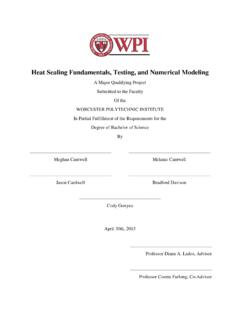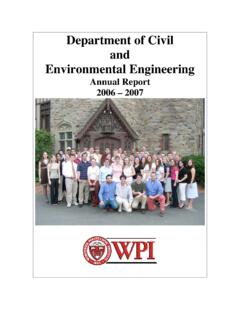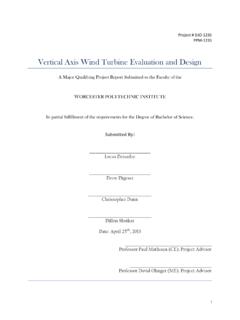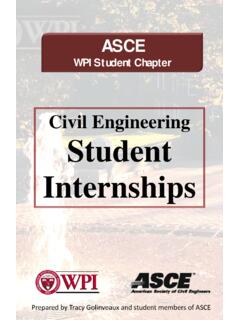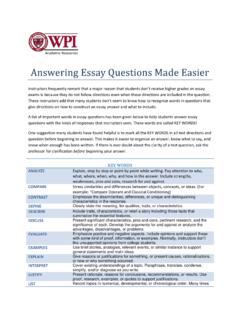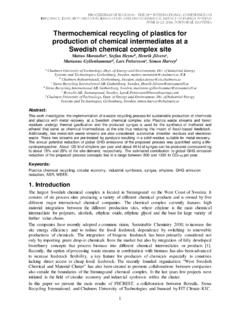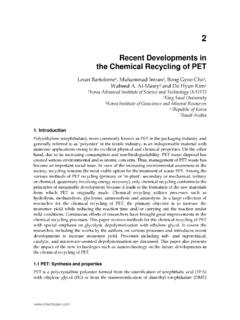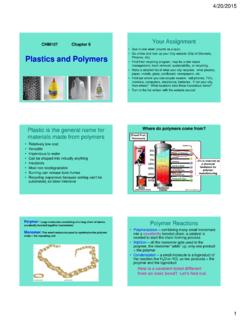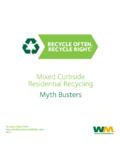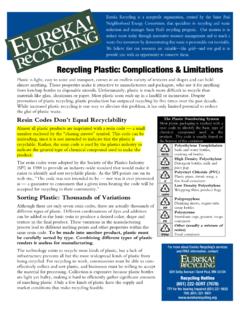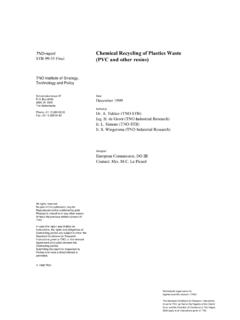Transcription of Reduce, Reuse, and Replace: A Study on Solutions to ...
1 Reduce, reuse , and replace : A Study on Solutions to Plastic Wastes An Interactive Qualifying Project Submitted to the faculty of Worcester Polytechnic Institute May 5, 2009 By Ningwei Li Dilasha Mahat Seonhee Park Project Advisor: Professor Robert W. Thompson 2 Abstract This project aimed to examine the quantities of plastic wastes discarded and the fate of various plastics in the environment. Our Interactive Qualifying Project was concerned with researching the possible alternatives to plastics , mainly biodegradable plastics that have been claimed to biodegrade and help environment. Moreover, it was also required to evaluate the best methods to deal with our plastic wastes that are environmentally, economically, and energy-wise viable. 3 Acknowledgement We would like to thank a number of people who greatly helped us and shared their knowledge and experiences to complete this project.
2 First we would like to thank faculty members, who were generous enough to take time to answer our questions; Professor Zhou, Mr. Hutson, Professor Brisson, Professor Fehribach, Professor Padir, Mr. Thomsen, Professor Dollenmayer, Professor Masamune, Miss Kumar, and Professor Pietroforte. We would also like to thank Mr. Kraskousakas, director of the Chartwells Services, and Ms. Tomaszeski, the coordinator of the Sustainability and the manager of the Facilities systems, for providing us information on recycling programs and plastic uses in WPI. Finally, we would like to express our sincere gratitude to our advisor, Professor Robert W. Thompson, for guiding and providing feedbacks to us throughout the project. 4 Acronyms ABS: Acrylonitrile-Butadiene-Styrene BBzP: Butyl Benzyl Phthalate BLL: Blood Lead Level BPA: Bisphenol A BPI: International Biodegradable Products Institute of the United States BPS: Biodegradable plastics society of Japan DEHA: Bis(2-ethylhexyl) Adipate DEHP: Bis(2-ethylhexyl)Phthalate EPA: Environmental Protection Agency HDPE: High Density Polyethylene HIPS: High-Impact Polystyrene LDPE: Low Density Polyethylene LLDPE: Linear Low Density Polyethylene MSW: Municipal Solid Waste PAYT: Pay-As-You-Throw PET: Polyethylene Terephthalate PHA: Polyhydroxyalkanoate PHB: Polyhydroxybutyrate PLA: Polylactic Acid PLGA: Poly (lactic-co-glycolic acid) PP: Polypropylene PS: Polystyrene PUF: Polyurethane Foams 5 PVC: Polyvinyl Chloride WPI.
3 Worcester Polytechnic Institute 6 Glossary Downcycling: process where the recycled/reproduce product has inferior quality than the original product MSW: more commonly known as trash or garbage, consists of everyday items such as product packaging, grass clippings, furniture, bottles, food scraps, newspapers, appliances, paint, and batteries (EPA). Recyclates: recycled materials that will be used to form new products (AggRegain 2009) Shredder residue: remaining particles after the sorting processed by the trammel in the recycling industry Trommels: screening devices used in the recycling industry for sorting particles of different sizes 7 Table of Contents Abstract Error! Bookmark not defined. Acknowledgement 3 Acronyms 4 Glossary 6 Table of Tables 8 Table of Figures 9 Background 10 plastics 10 Problems of plastics 18 Solutions to the Problems of plastics 26 Examples from the Real World 54 Methodology 59 Analysis 61 Chemical Decomposing 61 Reduced use of plastics 62 Recycling 64 Biodegradable plastics 67 WPI 71 Conclusion and Recommendations 74 Appendix 78 Interview Summaries 78 References 99 8 Table of Tables Table 1 Table of Different Types of plastics 12 Table 2 Number of Population Served by Curbside Programs in 2007 33 9 Table of Figures Figure 1 MSW Generation Rates from 1960 to 2006 23 Figure 2 Total MSW Generations 24 Figure 3 How the Bottles Bill Works 32 Figure 4 The States with Bottles Bills 32 Figure 5 Bulk Separation and
4 Size Reduction Process 35 Figure 6 Froth Flotation Process 36 10 Background plastics Definition of plastics Plastic is a kind of material that is commonly known and used in everyday life. To define plastic at molecular level, plastic is a kind of organic polymer, which has molecules containing long carbon chains as their backbones with repeating units. The structure of these repeating units and types of atoms play the main role in determining the characteristics of the plastic. These long carbon chains are well packed together by entanglements and Van der Waals forces between large molecules, and form a strong, usually ductile solid material. Also, additives are usually added when manufacturing of commercial plastics is carried on, in order to improve the strength, durability or grant the plastic specific characteristics.
5 Generally, there are two kinds of commercial plastics , thermoplastic and thermosetting plastic. Thermoplastics can be reheated, melted, and molded into different shapes, while thermosetting plastic will degrade and turn into other substances if reheated after molding. The molecules of thermoplastics are packed together by entanglements and Van der Waals forces. When a thermoplastic is heated up, it loses its entanglements and its molecules get farther away from each other, which causes the plastic changing from solid to liquid without breaking the bonds within the molecules. On the other hand, the molecules of thermosetting plastic are packed together not only by entanglements and Van der Waals forces, but also by the cross-links between molecules. When a thermosetting plastic is heated up, the cross-linking 11 bonds between molecules break apart and the plastic turns into another substance when it melts, usually by decomposing (Callister and Rethwisch, Fundamentals of Materials Science and Engineering, 3rd Ed.)
6 2008) Why traditional plastics are not biodegradable The nature of traditional plastics is the reason why they cannot be biodegraded. The carbon chains of traditional plastics are too long and too well packed for microorganisms to digest, but if they are broken into small pieces the microorganisms will be able to degrade them. However, the breakdown process is too long for most of the traditional plastics , if there is no any artificial processing before being thrown in a landfill is involved. Therefore, before the plastics degrade themselves naturally, more plastics will be manufactured, causing increasing plastic pollution around the world. Types of plastics Today, there are many different types of plastics manufactured in the plastic industry. They are applied in different areas depending on their properties.
7 The table below summarizes names of all commonly used plastics , their properties, and applications. It shows the importance of plastic materials, since they are used in many different areas. 12 Table 1. Table of Different Types of plastics [Callister , Rethwisch, Trade Names, Characteristics, and Typical Applications for a Number of Plastic Materials 2008] Material Type & Structure Trade Names Major Application Characteristics Typical Application Thermoplastics Acrylonitrile-butadience-styrene (ABS) Abson Cycolac Kralastic Lustran Novodur Tybrene Outstanding strength and toughness, resistant to heat distortion; Good electrical properties; Flammable and soluble in some organic solvents. Refrigerator linings, lawn and garden equipment, toys, highway safety devices Acrilycs [poly (methylmethacrylate)] Acrylite Diakon Lucite Plexiglas Outstanding light transmission and resistance to weathering; only fair mechanical properties Lenses, transparent aircraft enclosures, drafting equipment, outdoor signs 13 Fluorocarbons (PTFE or TFE) Teflon Fluon Halar Hostaflon TF Neoflon Chemically inert in almost all environments, excellent electrical properties; Low coefficient of friction; may be used to 260 Celsius.
8 Relatively weak and poor cold-flow properties Anticorrosive seals, Chemical pipes and valves, bearings, anti-adhesive coatings, high-temperature electronic parts Polyadmides (nylons) Nylon Baylon Durethan Herox Nomex Ultramid Zytel Good mechanical strength, abrasion resistance, and toughness; Low coefficient of friction; absorbs water and some other liquids Bearings, gears, cams, bushings, handles, and jacketing for wires and cables Polycarbonates Calibre Iupilon Lexan Makrolon Merlon Dimensionally stable; Low water absorption; transparent; very good impact Safety helmets, lenses, light globes, bas for 14 resistance and ductility; chemical resistance not outstanding photographic film Polyethylene Alathon Alkathene Fortiflex Hi-fax Petrothene Rigidex Rotothene Zendel Chemically resistant and electrically insulating; tough and relatively low coefficient of friction; low strength and poor resistance to weathering Flexible bottles, toys, tumblers, battery parts, ice trays, film wrapping materials Polypropylenes Herculon Meraklon Moplen Poly-pro Pro-fax Propak Propathene Resistance to heat distortion; excellent electrical properties and fatigue strength; chemically inert; relatively inexpensive; poor resistance to UV light Sterlizable bottles, packaging film, TV cabinets, luggage Polystyrenes Carinex Dylene Hostyren Lustrex Excellent electrical properties and optical clarity.
9 Good thermal and Wall tile, battery cases, toys, indoor lighting 15 Styron Vestyron dimensional stability; relatively inexpensive panels, appliance housings Vinyls Darvic Exon Geon Pliovic Saran Tygon Vista Good low-cost, general-purpose materials; ordinary rigid, but may be made flexible with plasticizers; often copolymerized; susceptible to heat distortion Floor coverings, pipe, electrical wire insulation, garden hose, phonograph records Polyesters (PET or PETE) Celanar Dacron Eastapak Hylar Melinex Mylar Petra One of the toughest of plastics films; excellent fatigue and tear strength, and resistance to humidity, acids, greases, oils, and solvents Magnetic recording tapes, clothing, automotive tire cords, beverage containers Thermosetting Polymers Epoxies Araldite Epikote Epon Excellent combination of mechanical Electrical moldings, sinks 16 Magnitude of the plastics Industry From computer shells to water bottles, plastics are everywhere in our everyday life.
10 In fact, plastics are not only important to our life, but also crucial to the economy. Epi-rez Lekutherm Lytex properties and corrosion resistance; good adhesion; relatively inexpensive; good electrical properties adhesives, protective coatings, used with fiberglass laminates. Phenolics Bakelite Amberol Arofene Durite Resinox Excellent thermal stability to over 150C; may be compounded with a large number of resins, fillers, etc; in expensive Motor housings, telephones, auto distributors, electrical fixtures Polyesters Aropol Baygal Derakane Laminac Selectron Excellent electrical properties and low cost; can be formulated for room-or-high-temperature use; often fiber reinforced Helmets, fiberglass boats, auto body components, chairs, fans 17 According to the statistics by American Chemistry Council, the production of major plastic resins was billion pounds.
